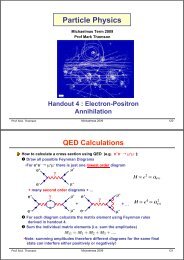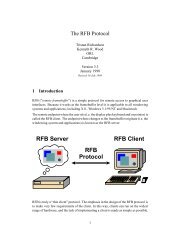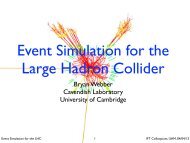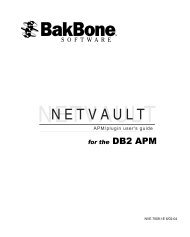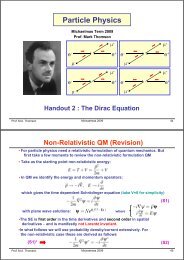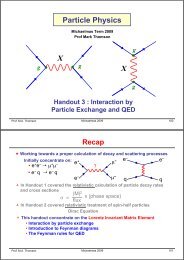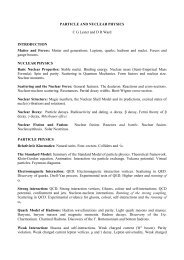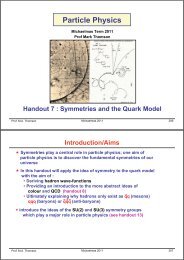ILD LoI : Optimisation and Performance - High Energy Physics Group
ILD LoI : Optimisation and Performance - High Energy Physics Group
ILD LoI : Optimisation and Performance - High Energy Physics Group
You also want an ePaper? Increase the reach of your titles
YUMPU automatically turns print PDFs into web optimized ePapers that Google loves.
The <strong>ILD</strong> Letter of Intent:<br />
<strong>Optimisation</strong> <strong>and</strong> <strong>Performance</strong><br />
Mark Thomson<br />
for the <strong>ILD</strong> group<br />
This talk:<br />
Introduction<br />
<strong>Optimisation</strong> of <strong>ILD</strong><br />
(GLD/LDC<strong>ILD</strong>)<br />
<strong>Performance</strong><br />
Conclusions
Introduction<br />
Design Requirements<br />
• ILC provides a clean environment for high precision measurements<br />
• Optimise detector to take full advantage of ILC<br />
• Requires high precision/high efficiency tracking<br />
• Excellent vertex tagging capabilities<br />
• Unprecedented jet energy resolution<br />
International Large Detector: Philosophy<br />
• Based on high granularity particle flow calorimetry<br />
• confident this will provide necessary jet energy resolution<br />
• “Large” central Time Projection Chamber (TPC)<br />
• proven technology; provides excellent pattern recognition<br />
in a dense track environment<br />
• Tracking augmented by Si strip/pixels<br />
• extend tracking coverage + improves precision<br />
• A high precision Vertex detector close to IP<br />
• for best possible heavy flavour tagging<br />
• Close to 4π tracking/calorimetric acceptance<br />
TILC09, Tsukuba, 17/04/2009 Mark Thomson 2
TILC09, Tsukuba, 17/04/2009 Mark Thomson 3<br />
From GLD/LDC to <strong>ILD</strong><br />
History<br />
Late 2007: <strong>ILD</strong> formed from previous (Asian-dominated) GLD <strong>and</strong><br />
(European-dominated) LDC groups<br />
Jan 2008: first <strong>ILD</strong> meeting (DESY Zeuthen)<br />
Sep 2008: <strong>ILD</strong> baseline parameters chosen<br />
• not always an easy process - required compromises<br />
• choices based on physics arguments from extensive studies<br />
(the first part of this talk)<br />
• essentially unanimous agreement !<br />
Mar 2009: <strong>ILD</strong> Letter of Intent submitted, including<br />
• current underst<strong>and</strong>ing of <strong>ILD</strong> performance the second part of<br />
• wide range of physics studies<br />
this talk<br />
Huge amount of work by many people !<br />
Today I can only give a summary…<br />
For more details see <strong>LoI</strong>, supporting documents <strong>and</strong> parallel session talks
TILC09, Tsukuba, 17/04/2009 Mark Thomson 4<br />
<strong>Optimisation</strong><br />
Starting point: GLD <strong>and</strong> LDC concepts<br />
Many similarities:<br />
• both conceived as detectors for particle flow calorimetry with<br />
a TPC as the central tracker<br />
Significant differences:<br />
• overall parameters: size, magnetic field<br />
• sub-detector technologies<br />
Tracker<br />
R TPC =<br />
B =<br />
LDC<br />
TPC<br />
1.5 m<br />
4 T<br />
GLD<br />
TPC<br />
2.0 m<br />
3 T<br />
Vertex 5 single layers 3 double layers ?<br />
ECAL SiW pixels Scint strips ?<br />
HCAL<br />
Steel<br />
RPC<br />
<strong>ILD</strong> ?<br />
TPC<br />
1.5 – 2.0 m<br />
3 – 4 T<br />
Steel-Scint ?<br />
Scint
TILC09, Tsukuba, 17/04/2009 Mark Thomson 5<br />
Main <strong>ILD</strong> sub-detector options<br />
ECAL<br />
SiW: 5×5 mm 2<br />
ScintW: strips<br />
HCAL<br />
TPC<br />
HCAL<br />
Steel Scint.<br />
Analogue<br />
3×3 cm 2 tiles<br />
Steel RPC<br />
Digital<br />
1×1 cm 2<br />
MAPS: digital<br />
Vertex Detector<br />
3 Double Layers 5 Single Layers
TILC09, Tsukuba, 17/04/2009 Mark Thomson 6<br />
<strong>ILD</strong> <strong>Optimisation</strong>: Strategy<br />
Scope of <strong>Optimisation</strong>:<br />
• Concentrate on global detector parameters:<br />
- radius, B-field, HCAL thickness, …<br />
Parameter space:<br />
• study parameters between/close to GLD <strong>and</strong> LDC<br />
Sub-detector technology:<br />
• At this stage we are not in a position to choose between<br />
different options – different levels of sophistication in<br />
simulation/reconstruction<br />
• However, can demonstrate a certain technology/resolution<br />
meets the ILC goals<br />
Cost:<br />
• Large uncertainties in raw materials/sensors<br />
• For this reason, do not believe optimising performance for<br />
given cost is particularly reliable at this stage<br />
• Whilst conscious of cost, meeting the required performance/<br />
physics goals is the main design criterion
TILC09, Tsukuba, 17/04/2009 Mark Thomson 7<br />
<strong>ILD</strong> <strong>Optimisation</strong>: detector models<br />
<strong>Optimisation</strong> studies performed using both GLD <strong>and</strong> LDC software<br />
• useful cross-check of results<br />
• simulated an LDC-sized detector in GLD software <strong>and</strong> vice versa<br />
• simulated an intermediate (B=3.5 T) model in each framework<br />
Considered 3 “benchmark” detectors in both software frameworks:<br />
• Jupiter : GLD, GLDPrime, GLD4LDC<br />
• Mokka : LDC4GLD, LDCPrime, LDC<br />
“Big” Medium “Small”<br />
Sub-Detector Parameter GLD LDC GLD’ LDC’<br />
TPC R outer (m) 1.98 1.51 1.74 1.73<br />
Barrel ECAL R inner (m) 2.10 1.61 1.85 1.82<br />
Material Sci/W Si/W Sci/W Si/W<br />
Barrel HCAL Material Sci/Fe Sci/Fe Sci/Fe Sci/Fe<br />
Solenoid B-field 3.0 4.0 3.50 3.50<br />
VTX Inner Layer (mm) 17.5 14.0 16 15
TILC09, Tsukuba, 17/04/2009 Mark Thomson 8<br />
<strong>ILD</strong> <strong>Optimisation</strong>: Software<br />
Significant effort to make things as realistic as possible<br />
• Include: realistic geometry, gaps, dead material, support structures<br />
• Not perfect, but probably a decent first order estimate<br />
e.g. Vertex detectors in Mokka<br />
VTX-SL: 5 single layers<br />
VTX-DL: 3 double layers<br />
NOTE: for the tracking detector point resolutions are applied<br />
in reconstruction (digitisation stage)<br />
All studies use sophisticated full reconstruction chain
<strong>ILD</strong> <strong>Optimisation</strong>: Particle Flow<br />
Role of Particle Flow in <strong>ILD</strong> optimisation<br />
<strong>ILD</strong> designed for Particle Flow Calorimetry<br />
Plays an important role in the detector optimisation<br />
• essential to that <strong>ILD</strong> meets ILC jet energy goals<br />
ILC Jet <strong>Energy</strong> Goals<br />
Not 30%/√E<br />
Want to separate W <strong>and</strong> Z di-jet decays<br />
For di-jet mass resolution of order<br />
~2.75σ separation between W <strong>and</strong> Z peaks<br />
All studies use sophisticated full reconstruction, e.g. Marlin<br />
Note: better jet energy resolution enables tighter cuts to be made<br />
in event selections where invariant mass cuts are important<br />
TILC09, Tsukuba, 17/04/2009 Mark Thomson 9
TILC09, Tsukuba, 17/04/2009 Mark Thomson 10<br />
PFA <strong>Optimisation</strong>: HCAL Depth<br />
HCAL chosen to be sufficiently deep that<br />
leakage does not significantly degrade PFA<br />
Studies include attempt to use muon chambers<br />
as a hadron shower “tail-catcher”<br />
Somewhat limited by thick solenoid<br />
Vary number of layers in LDCPrime HCAL<br />
HCAL<br />
λ I<br />
Layers HCAL +ECAL<br />
32 4.0 4.8<br />
38 4.7 5.5<br />
43 5.4 6.2<br />
48 6.0 6.8<br />
63 7.9 8.7<br />
Suggests that <strong>ILD</strong> HCAL should be 43 – 48 layers (5.4-6.0 λ I )<br />
48 layers chosen
TILC09, Tsukuba, 17/04/2009 Mark Thomson 11<br />
PFA <strong>Optimisation</strong>: Calorimeter Segmentation<br />
Starting from LDCPrime vary ECAL Si pixel size <strong>and</strong> HCAL tile size<br />
ECAL Conclusions:<br />
• Ability to resolve photons in current P<strong>and</strong>oraPFA algorithm strongly<br />
dependent on transverse cell size<br />
• Require at least as fine as 10x10 mm 2 to achieve 3.8 % jet E resolution<br />
• Significant advantages in going to 5x5 mm 2<br />
• For 45 GeV jets resolution dominates (confusion relatively small)<br />
HCAL Conclusions:<br />
• For current P<strong>and</strong>oraPFA algorithm <strong>and</strong> Scintillator (analogue) HCAL<br />
a tile size of 3×3 cm 2 looks optimal
PFA <strong>Optimisation</strong>: B vs Radius<br />
Starting from LDCPrime (B=4.0 T, r ECAL =1825 mm) vary B <strong>and</strong> R<br />
Empirically find<br />
Resolution Tracking Leakage Confusion<br />
Conclude:<br />
• R is more important than B for PFA performance<br />
• Confusion term ∝ B -0.3 R -1<br />
• For 45 GeV jets resolution dominates (confusion relatively small)<br />
TILC09, Tsukuba, 17/04/2009 Mark Thomson 12
TILC09, Tsukuba, 17/04/2009 Mark Thomson 13<br />
PFA <strong>Optimisation</strong>: B vs Radius<br />
Comparing LDC, LDCPrime <strong>and</strong> LDC4GLD jet energy resolutions<br />
Relative to<br />
LDCPrime<br />
B/T<br />
R/m<br />
Relative σ E<br />
/E vs E JET<br />
/GeV<br />
B -0.3 R -1 45 100 180 250<br />
LDC 4.0 1.6 1.08 1.02 1.04 1.05 1.06<br />
LDCPrime 3.5 1.8 1.00 1.00 1.00 1.00 1.00<br />
LDC4GLD 3.0 2.0 0.95 0.99 0.97 0.96 0.96<br />
Conclude:<br />
• Differences between GLD <strong>and</strong> LDC are small<br />
• Not surprising: original detector parameters chosen such that higher<br />
B (partly) compensates for smaller radius<br />
• Of the models considered the larger radius, lower field combination is<br />
slightly favoured, but at most 5 % differences.<br />
B <strong>and</strong> R not only affect particle flow…
<strong>ILD</strong> <strong>Optimisation</strong>: Tracking<br />
Compare GLD, GLDPrime <strong>and</strong> GLD4LDC momentum resolution <strong>and</strong><br />
GLDPrime <strong>and</strong> LDCPrime impact parameter resolution<br />
Conclude:<br />
• All models give the required performance with only ~5-10 % differences<br />
• For high momentum tracks:<br />
• LDC is favoured over GLD but only by ~5 % (larger lever arm)<br />
• The 3 double layer Vertex detector is favoured – two high precision<br />
points close to the IP rather than one<br />
• Dependence on point resolution + detector layout/technology likely<br />
to be much larger than differences observed here<br />
TILC09, Tsukuba, 17/04/2009 Mark Thomson 14
TILC09, Tsukuba, 17/04/2009 Mark Thomson 15<br />
<strong>ILD</strong> <strong>Optimisation</strong>: Background considerations<br />
Large beam background of low p T<br />
electron/positron pairs<br />
• Radius of pair background envelope is determined by B<br />
• Determines the minimum inner radius of the vertex detector<br />
• Potential to impact flavour tagging performance<br />
But radius of pair background envelope scales only as √B<br />
Dependence of inner radius of vertex detector is weaker than √B<br />
• fixed clearance between background <strong>and</strong> beam pipe <strong>and</strong> beam pipe <strong>and</strong> vertex detector<br />
Consequently 4 T 3 T translates to a ~10 % difference in inner radius<br />
of vertex detector
<strong>ILD</strong> <strong>Optimisation</strong>: Flavour Tagging<br />
Compare flavour tagging performance for GLD <strong>and</strong> LDC based models<br />
• Differences of 2.5 mm in inner radius of beam pipe due to B field<br />
Use “State-of-the-Art” LCFIVertex algorithms<br />
• ANNs separately tuned for the different detector models<br />
• NOTE: ~2% stat. uncertainties on results from ANN training/finite stats.<br />
Conclude:<br />
• Differences are not large<br />
• <strong>High</strong>er B (smaller inner radius) slightly favoured – but not conclusive<br />
due to statistical uncertainties<br />
• Does not provide a strong argument for higher field<br />
TILC09, Tsukuba, 17/04/2009 Mark Thomson 16
<strong>ILD</strong> <strong>Optimisation</strong>: <strong>Physics</strong><br />
Also compared physics performance for GLD <strong>and</strong> LDC based models<br />
• Higgs mass from<br />
• W/Z reconstruction in SUSY Point 5 chargino/neutralino analysis<br />
• Tau reconstruction/polarisation<br />
Only significant difference found for full<br />
reconstruction of tau decay, e.g.<br />
For reconstruction of both photons from<br />
• 5×5 mm 2 is a significant advantage<br />
• larger radius also helps<br />
But impact on physics sensitivity less pronounced<br />
TILC09, Tsukuba, 17/04/2009 Mark Thomson 17
TILC09, Tsukuba, 17/04/2009 Mark Thomson 18<br />
<strong>ILD</strong> <strong>Optimisation</strong>: Summary<br />
What did we learn ? (much more detail in <strong>LoI</strong>)<br />
B/T r<br />
LDC, “Prime”, GLD give similar performance<br />
ECAL<br />
/m<br />
• almost by “construction”<br />
LDC 4.0 1.6<br />
• all valid detector concepts for ILC<br />
Prime 3.5 1.8<br />
For PFlow, radius is more important than B<br />
Arguments for high B are rather weak<br />
For current PFlow algorithm want segmentation<br />
GLD 3.0 2.0<br />
• ECAL < 10×10 mm 2 (5×5 mm 2 preferred)<br />
• HCAL ~ 3×3 cm 2 (no obvious advantage in higher granular for analogue HCAL)<br />
Choice of <strong>ILD</strong> parameters<br />
B = 3.5 T<br />
• not a big extrapolation from CMS solenoid (larger)<br />
• only weak arguments for higher field<br />
• 3.0 T viable, but would like to better underst<strong>and</strong> backgrounds<br />
r ECAL<br />
= 1.85 m<br />
• for B = 3.5 T need ~1.55 m to reach jet E goal<br />
• then allow for uncertainties in shower simulation<br />
• larger radius brings performance advantages (~16 % for 1.85 c.f. 1.55)<br />
Technology<br />
• no selection at this stage
<strong>ILD</strong> Detector <strong>Performance</strong><br />
Defined detailed GEANT4 model of <strong>ILD</strong> “software reference” model<br />
For this software model use sub-detector models for which full<br />
reconstruction performance has been established<br />
ECAL: SiW: 5×5 mm 2<br />
• Advantages of high segmentation<br />
• PFA with strip clustering not yet<br />
demonstrated (needs R&D)<br />
• ditto PFA with MAPS ECAL<br />
HCAL: 3x3 cm 2 Scint. tiles<br />
• PFA with digital/semi-digital<br />
HCAL not yet fully demonstrated<br />
• First studies indicate comparable perf.<br />
VTX: 3 double layer layout<br />
• slightly better impact parameter res.<br />
• Interesting to study potential<br />
pattern recognition advantages<br />
Si Tracking: SiLC design<br />
• coverage down to 6 o<br />
Level of detail in GEANT4 model probably as good as most TDRs !<br />
TILC09, Tsukuba, 17/04/2009 Mark Thomson 19
<strong>Performance</strong> <strong>High</strong>lights: Track Finding Efficiency<br />
Achieve very high track reconstruction efficiency (full reconstruction)<br />
For<br />
TPC only plot<br />
is different to<br />
that in <strong>LoI</strong> due<br />
to a, now fixed,<br />
software issue<br />
For (p>1 GeV) efficiency is greater than 99.5 % for any track leaving<br />
4+ hits in tracking detectors (includes V 0 s <strong>and</strong> kinks)<br />
NOTE: beam background not included<br />
• Subject of on-going work<br />
• Studies to date do not indicate any problems with background<br />
• However, studies require improvements to digitisation/reconstruction of time<br />
structure of bunch train to make solid statements<br />
TILC09, Tsukuba, 17/04/2009 Mark Thomson 20
TILC09, Tsukuba, 17/04/2009 Mark Thomson 21<br />
Particle Flow <strong>Performance</strong><br />
Benchmarked using:<br />
• decays<br />
at rest<br />
• |cosθ|
TILC09, Tsukuba, 17/04/2009 Mark Thomson 22<br />
Previously argued aiming for σ(E jet )/E jet < 3.8 %<br />
<strong>ILD</strong> meets this requirement for 40-400 GeV jets<br />
Excellent jet energy resolution is a strength of <strong>ILD</strong> !
TILC09, Tsukuba, 17/04/2009 Mark Thomson 23<br />
<strong>ILD</strong> <strong>Physics</strong> <strong>Performance</strong><br />
<strong>ILD</strong> <strong>Physics</strong> Studies:<br />
• Extensive set of analyses developed for <strong>LoI</strong><br />
• “benchmark” <strong>and</strong> many other processes<br />
• All use full simulation/reconstruction<br />
• Large scale grid-based MC production ~30M events !<br />
• Based on StdHep files generated at SLAC<br />
• Two experienced reviewers assigned to each analysis<br />
to give some level of feedback/quality assurance<br />
Caveats:<br />
A lot of impressive work from many people !<br />
• Different analyses have different levels of sophistication<br />
• Not the ultimate performance that can be achieved<br />
• don’t draw too strong conclusions yet<br />
• except perhaps – that <strong>ILD</strong> is an excellent general purpose<br />
detector for the ILC<br />
Due to time constraints can only give “highlights” here…<br />
Significantly more in the <strong>LoI</strong>
: Higgs Recoil Mass<br />
TILC09, Tsukuba, 17/04/2009 Mark Thomson 24<br />
Model independent determination of Higgs mass from<br />
Higgsstrahlung events at √s = 250 GeV<br />
Measure four-momentum of Z from its decays to e + e - /µ + µ -<br />
Determine Higgs four momentum from recoil mass<br />
assuming √s = 250 GeV for underlying e + e - collision<br />
Resolution limited by:<br />
• momentum resolution<br />
• beamstralung<br />
• +bremβtrahlung for electron final state<br />
Select events using only information from di-lepton system<br />
(250 fb -1 )<br />
Significant Bhabha<br />
background
TILC09, Tsukuba, 17/04/2009 Mark Thomson 25<br />
Model independent<br />
results:<br />
Pol(e - ,e + ) Channel σ(m H ) Cross-section (<strong>LoI</strong>)<br />
-80 %, +30%<br />
σ(m H ) = 74 MeV<br />
µµX 85 MeV ±0.70 fb (6.6 %)<br />
eeX 150 MeV ±1.15 fb (9.8%)<br />
In Model Dependent analysis (i.e. assuming SM<br />
Higgs decays) SM background ~ halved<br />
σ(m H ) = 67 MeV<br />
Relation to detector performance<br />
• This is a benchmark analysis for momentum resolution performance<br />
• Beamstrahlung <strong>and</strong> beam energy spread<br />
also impact recoil mass resolution<br />
• Width of µµX recoil mass peak:<br />
• 730 MeV for perfect resolution<br />
• 870 MeV after reconstruction<br />
• Here beam effects dominate !<br />
• NOTE: mc generation assumed 0.3 %<br />
Gaussian beam energy spread<br />
Interpretation depends strongly on whether lumi. spectrum is realistic
: Higgs Branching ratios<br />
TILC09, Tsukuba, 17/04/2009 Mark Thomson 26<br />
Determine BR(Hbb), BR(Hcc), BR(Hgg) from Higgs-strahlung events<br />
Test of flavour tagging performance<br />
Cut based selections of three HZ decay topologies<br />
qqνν qqµµ /qqee qqqq<br />
Apply b-tags <strong>and</strong> c-tags to jets from c<strong>and</strong>idate Higgs decay<br />
e.g. qqqq analysis:<br />
• Combine b (or c) tags from the two jets<br />
• Plot b-likeness vs. c-likeness<br />
• Fit using templates to give exclusive σ
TILC09, Tsukuba, 17/04/2009 Mark Thomson 27<br />
Combine with from model independent analysis<br />
(for <strong>LoI</strong> 5 % uncertainty) to give BRs<br />
Channel Br(Hbb) Br(Hcc) Br(Hgg)<br />
ZHqqcc 30 ⊕ 5 %<br />
ZHννqq 5.1 ⊕ 5 % 19 ⊕ 5 %<br />
ZHllqq 2.7 ⊕ 5 % 28 ⊕ 5 % 29 ⊕ 5 %<br />
Combined 5.5 % 15 % 29%<br />
Results broadly consistent with Tesla TDR (taking into account different<br />
lumi. <strong>and</strong> different √s)<br />
Relation to detector performance<br />
• Current sensitivities probably more a measure<br />
of sophistication of the analysis rather than<br />
ultimate detector performance, i.e. can<br />
improve multi-variate (e.g. ANN)<br />
• nonetheless, good performance achieved<br />
• NOTE: in vvqq analysis Higgs di-jet mass<br />
resolution feeds into final sensitivity
TILC09, Tsukuba, 17/04/2009 Mark Thomson 28<br />
Chargino <strong>and</strong> Neutralino Production at √s = 500 GeV<br />
Chargino <strong>and</strong> neutralino production in the SUSY “point 5” scenario<br />
provides a benchmark for jet energy resolution<br />
<br />
<strong>and</strong><br />
result in final states with four jets <strong>and</strong> missing energy<br />
Neutralino process is challenging: cross section ~10% chargino<br />
Only time to describe one<br />
of two analyses in <strong>LoI</strong>: method i)<br />
Analysis:<br />
• Select 4 jet + missing E events<br />
• Three possible jet-pairings<br />
• Kin. fit assuming common di-jet mass for<br />
two bosons applied to each jet-pairing<br />
• Jet-pairing giving highest fit prob used<br />
• Fit mass distribution to i) SM, ii) chargino<br />
<strong>and</strong> iii) neutralino components to get<br />
cross sections
TILC09, Tsukuba, 17/04/2009 Mark Thomson 29<br />
Chargino <strong>and</strong> Neutralino Production at √s = 500 GeV<br />
Chargino <strong>and</strong> neutralino production in the SUSY “point 5” scenario<br />
provides a benchmark for jet energy resolution<br />
<br />
<strong>and</strong><br />
result in final states with four jets <strong>and</strong> missing energy<br />
Neutralino process is challenging: cross section ~10% chargino<br />
Only time to describe one<br />
of two analyses in <strong>LoI</strong>: method i)<br />
Analysis:<br />
• Select 4 jet + missing E events<br />
• Three possible jet-pairings<br />
500 fb -1<br />
• Kin. fit assuming common di-jet mass for<br />
two bosons applied to each jet-pairing<br />
• Jet-pairing giving highest fit prob used<br />
• Fit mass distribution to i) SM, ii) chargino<br />
<strong>and</strong> iii) neutralino components to get<br />
cross sections
0.6 %<br />
2.1 %<br />
NOTE: Good jet energy resolution essential to extract neutralino<br />
signal from much larger chargino “background”<br />
Gaugino masses can be reconstructed from decay kinematics<br />
e.g.<br />
where masses of <strong>and</strong> from<br />
kinematic edges of Z energy dist.<br />
Excellent <strong>ILD</strong> jet energy resolution<br />
allows a sample of to<br />
be isolated from background<br />
Neutralino + chargino samples give:<br />
(method ii)<br />
NOTE: results correlated as mass differences better determined<br />
than mass sums<br />
TILC09, Tsukuba, 17/04/2009 Mark Thomson 30
Top production at √s = 500 GeV<br />
TILC09, Tsukuba, 17/04/2009 Mark Thomson 31<br />
At √s = 500 GeV top mass determined from direct reconstruction of final state<br />
Fully-hadronic <strong>and</strong> semi-leptonic<br />
Main analysis issue is that of jet combinatorics<br />
b-tag b-tag<br />
Use:<br />
• b-tagging<br />
m t<br />
• Invariant masses<br />
m t<br />
m W<br />
m W<br />
Final mass from kinematic fit using chosen jet associations<br />
500 fb -1
Stau production at √s = 500 GeV<br />
TILC09, Tsukuba, 17/04/2009 Mark Thomson 32<br />
For SUSY SPS1a’ parameters<br />
gives a relatively low visible energy final state<br />
Analysis requires:<br />
• precise tracking of low momentum particles<br />
• good particle identification<br />
• hermeticity<br />
Main analysis issue is very large<br />
two photon background<br />
Reduced to acceptable level<br />
by vetoing forward electron/positron<br />
in Beam Calorimeter<br />
Fit to endpoint of spectrum<br />
(mainly decays)<br />
e –<br />
(E τ<br />
~ 40 GeV)<br />
e –<br />
q<br />
q<br />
e +<br />
e +<br />
Post <strong>LoI</strong>: included beam background, precision essentially same
<strong>and</strong> finally…WW-scattering at √s = 1 TeV<br />
Study <strong>and</strong><br />
<strong>and</strong><br />
jets + missing energy<br />
e +<br />
e –<br />
W/Ζ<br />
W/Ζ<br />
in<br />
q 1<br />
q 2<br />
q 3<br />
q 4<br />
j 4<br />
j 1<br />
j 2 j 3<br />
“Classic” benchmark for jet energy resolution<br />
At 1 TeV clear separation is obtained between W <strong>and</strong> Z peaks with <strong>ILD</strong><br />
Limits on anomalous couplings similar to earlier fast simulation studies<br />
TILC09, Tsukuba, 17/04/2009 Mark Thomson 33
TILC09, Tsukuba, 17/04/2009 Mark Thomson 34<br />
<strong>Physics</strong> Summary<br />
• Only had time to give a flavour of<br />
physics studies in <strong>ILD</strong> <strong>LoI</strong><br />
• Whilst the results do not represent<br />
the ultimate precision achievable,<br />
they:<br />
Demonstrate the high level<br />
of performance of <strong>ILD</strong><br />
Demonstrate that <strong>ILD</strong> is an<br />
excellent general purpose<br />
detector concept for the ILC<br />
+ photon final states (GMSB/WIMPS)<br />
+ Littlest Higgs<br />
+ beam polarisation from WW
TILC09, Tsukuba, 17/04/2009 Mark Thomson 35<br />
Conclusions<br />
<strong>ILD</strong> is powerful general purpose detector for the ILC based<br />
on particle flow calorimetry<br />
The <strong>ILD</strong> parameters were chosen on the basis of an extensive<br />
series of optimisation studies<br />
• now have a much better underst<strong>and</strong>ing of the performance issues<br />
<strong>ILD</strong> meets the performance goals for a detector at the ILC<br />
• highly performant tracking<br />
• excellent flavour tagging capability<br />
• unprecedented jet energy resolution<br />
<strong>ILD</strong> physics studies have started in earnest, <strong>and</strong> the results<br />
presented in the <strong>LoI</strong> hopefully demonstrate the general<br />
purpose nature of the concept
Over to Sugimoto-san…<br />
TILC09, Tsukuba, 17/04/2009 Mark Thomson 36
Backup slides: tracking coverage <strong>and</strong> material<br />
TILC09, Tsukuba, 17/04/2009 Mark Thomson 37
Bacjup: <strong>ILD</strong> Flavour Tagging Efficiency<br />
TILC09, Tsukuba, 17/04/2009 Mark Thomson 38
TILC09, Tsukuba, 17/04/2009 Mark Thomson 39<br />
Backup : Flavour tagging: higher energies<br />
ANNs were not tuned for 250 GeV jets<br />
Flavour composition 91.2 GeV 500 GeV<br />
bb 22% 15%<br />
cc 17% 25%<br />
uu, dd, ss 61% 60%
Backup: <strong>ILD</strong> Tau Pairs<br />
TILC09, Tsukuba, 17/04/2009 Mark Thomson 40




